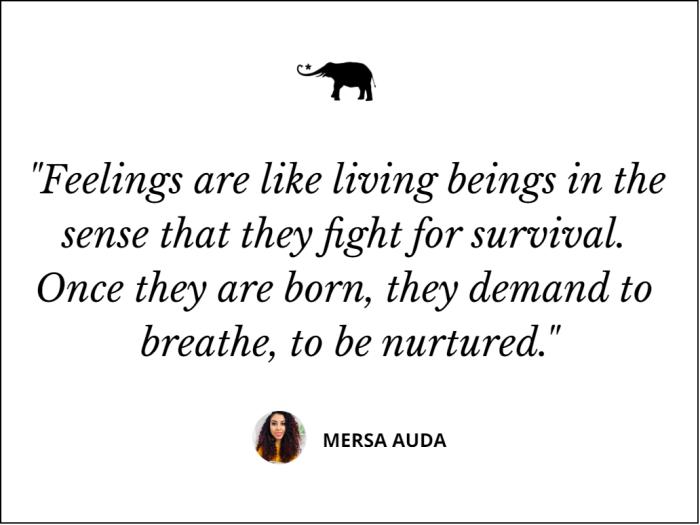
Photo by Ilya Kovalchuk on Pexels.
Feelings are born free, but we hold them captive.
As soon as we detect and acknowledge the existence of a feeling, we hasten to compartmentalise it and match it to a socially acceptable label. If we sense that something we feel could be viewed negatively for any reason, we suppress it.
We are forever comparing our truth with an ideal, and when the two don’t match, we bury the feeling and hold on to the ideal, thus betraying ourselves. We often take the choice that makes our external life easier, even if it makes our inner life more complicated. We go for the quick fix, and in time, we find ourselves burdened with unprocessed material that weighs us down, incapacitating us.
Feelings are born equal, but we instinctively nurture some and exile others. When we do accept it, a feeling completes its lifespan harmoniously: it emerges, expands, and then naturally dissipates, or it evolves into something else. The stray feelings that we can’t make sense of, the ones that seem to exist in spite of our best efforts to muffle them, are the ones that tend to cause damage. This is not because they are inherently harmful, but it’s due to our inability to handle them.
Feelings are like living beings in the sense that they fight for survival. Once they are born, they demand to breathe, to be nurtured. They will try to get your attention, quietly at first, but if you continue to ignore them, they’ll begin to scream. Then, they might get tired and just sob in a corner, quietly, so you can get on with your life, but loud enough that you are constantly reminded of them and affected by their existence.
Feelings know no boundaries or rules. They don’t care about our plans or the reputation we’re trying to uphold. They seem to show up unannounced, at the level of intensity that they choose. When our feelings pull us away from the idealised picture we have of ourselves, we tend to disconnect from them.
We learn to live life on two levels: the surface level, made of smiles and poker faces, and the feeling level, where authentic sensations and responses occur.
We would sooner blame our feelings for being too wild and chaotic rather than question the rigidity of our thinking. Our beliefs about how and what we should feel can become so solid over a lifetime that we eventually become enslaved by these self-imposed inflexible structures. We may hold the most logical arguments and have a pristine moral compass, but we can find these challenged at any time by our very own emotional reactions which are involuntary, instinctive, and speak a completely different language than the one spoken by reason.
This is when inner conflict occurs.
Many of the world’s rules are arbitrary, yet we often sacrifice our emotional well-being to accommodate them. But where should we draw the line?
The first step is to realise that all inner activity deserves to be acknowledged.
At its root, no feeling is ever wrong because it belongs to the natural spectrum of emotions that are part of the human experience. It might feel uncomfortable, and it might not have a home, but it’s there. What you feel is real—even when it doesn’t make sense to you and to the world outside. If you don’t give a feeling shelter, it will keep roaming within you, it will keep peeking its head outside, looking for acceptance and searching for a shape that allows it to exist, for a pretext to express itself. The feelings you censor don’t disappear; they come back to haunt you.
They will always seek an outlet.
Your unexpressed truths end up hiding wherever there’s a gap, and they wait for you there until you deal with them. The truth lies in the messages you write and never send, in the thoughts you abort, in the temptations you resist, in the fantasies you relegate to your inner jail. The truth will project itself onto any suitable surface or vessel it finds. It may sneak into the unguarded realms of your dreams as you sleep, or it may speak to you through a song.
One thing is for sure, the truth cannot be muted forever. There is a point when a feeling needs to be addressed and owned.
The next step, then, is to observe, listen, and feel it all.
We suppress feelings in an attempt to stay in control, but by moving them out of sight, we deny ourselves the opportunity to process them. A rejected feeling continues to exist, unchecked, and begins to take control, usually manifesting in unhealthy ways.
When we face what’s inside, we give ourselves the power to transform it into something productive and useful for our expansion. Anything you keep locked in one place stagnates, and anything that stagnates becomes toxic. We must give ourselves permission to look inside with a sense of curiosity and honour what we find, and allow it to come up and give it room to breathe, to just be.
We could stop and, for a brief moment, suspend all that we have learnt about the world, giving precedence to our own perspective, remembering that all feelings are valid and have a right to exist, even if they don’t coincide with societal standards. Once full acceptance takes place, we are one step closer to getting to know ourselves, and closer to no longer fearing the emotional experience that we wrestled with.
Feelings are a part of who we are. To enter and inhabit a feeling when it arises, to honestly admit that it exists, and then to handle this feeling in the most gracious way we know until a healthy course of action takes shape: this could be the way to live life fully as emotional beings.
~

Beautifully written and very accurate ♥️
Read 1 more comment